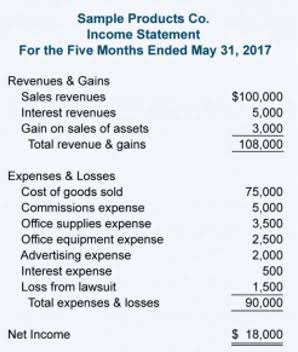
By using this template, users could understand whether the entity could generate profit from operating activities or not. Once we include all of the non-operating items, we will get net profit or net income. Other items that are not related to operating activities will be recorded in the next step. Non-operating expenses are the expenses that are non-related to the entity’s daily operation. For example, interest expenses and other expenses that spend by the entity like selling of fixed assets.
Who Uses Single-Step Income Statements?
Many companies use the multi step income statement as one of their key financial reports. Three of the most popular accounting software solutions – QuickBooks, Xero, and Sage Intacct, all allow for creating multi step income statements. Businesses can control the format of the report, and make sure all the important information is easy to read. Next, we calculate operating income (also known as earnings before interest and taxes – EBIT). Single-step income statements are easier to prepare and require less calculations. For many small businesses, the single-step income statement provides all the details you’ll need to assess the financial health of your company.
- You should consult your own legal, tax or accounting advisors before engaging in any transaction.
- It’s always important to view comparative financial statements over time, so you can see trends and possibly catch misleading placement of expenses.
- Investors also use the gross profit to determine the profitability of primary business activities and the general health of the company.
- The multi-step format lists components like revenue, cost of goods sold, operating expenses, interest, and taxes in distinct sections.
- The content on this website is provided “as is;” no representations are made that the content is error-free.
- A multi-step income statement reports a company’s revenues, expenses and overall profit or loss for a specific reporting period.
- The final step in preparing a multi-step income statement is calculating the net income, which represents the total earnings of the company after all expenses, including taxes, have been deducted.
Examples of Multi-Step Income Statements

Investors and creditors want to know how efficiently the retailer sells its merchandise without diluting the numbers with other gains and losses from non-merchandise related sales. Finally, we arrive at the net income, which represents the company’s total profit after all expenses, including taxes, have been deducted. Misclassification of financial items is another common error that can affect the analysis of a multi-step income statement. When preparing and analyzing a multi-step income statement, certain pitfalls can significantly affect the accuracy and usefulness of the financial document. Understanding these Medical Billing Process common mistakes can help ensure the integrity of the financial analysis. Income tax expense is the amount of money a company owes to the government based on its taxable income.
AccountingTools

A multi-step income statement is ideal for large, complex businesses that use a long list of incomes and expenses. The multi-step income statement template contains Gross Profit as the first section. The calculation of the first section shows the gross profit of business by deducting the cost of goods sold (COGS) from the total sales. multi step income statement It is an important figure for the creditors, investors, and internal management as it depicts how profitable a company is at selling the goods or making the products.
- Operating expenses, such as payroll and rent, are then deducted to find income from operations.
- The other core financial statements are the balance sheet and cash flow statement.
- On the other hand, a multi step income statement breaks down revenues, expenses, gains, and losses into separate sections.
- It is simply Cash Inflow from Merchandise sales and Cash Outflow from purchasing the merchandise.
Single Step Statement Example
It’s a key indicator of a company’s efficiency in managing its production costs. A low gross profit margin signals potential issues with pricing, cost control, or inventory management. Preparing the multi-step income statement is beneficial for medium to big corporations to keep track of their income. As the revenue and expenses are segregated into operating and non-operating accounts, it provides greater insight into the company’s financial performance.
As a small business, you have two options for retained earnings preparing an income statement — a single-step income statement and a multi-step income statement. Both types of income statements will show the profits, expenses, and revenues of your business for a given reporting period. However, a multi-step income statement offers a more in-depth analysis of your business’s financial performance. This allows stakeholders to analyze the company’s operational efficiency, cost management, and overall financial health in a detailed manner. Preparing a multi-step income statement involves a detailed breakdown of revenues and expenses, allowing for a comprehensive analysis of a company’s financial health.


Typically, publicly-traded companies prepare and publish a Multi-Step Income Statement quarterly and annually. However, for internal purposes, companies might prepare them monthly or as required for better financial monitoring. Users may want to know how is the current margin against the previous period and industry averages. As well as how good the chief executive is in leading the company since the non-operation sections are not related to their performance. Below is a break down of subject weightings in the FMVA® financial analyst program. As you can see there is a heavy focus on financial modeling, finance, Excel, business valuation, budgeting/forecasting, PowerPoint presentations, accounting and business strategy.

It offers a transparent view of the company’s financial activity, revealing trends in sales, cost management, and profitability over time. By presenting a clear distinction between operating and non-operating activities, it helps stakeholders understand the company’s true earning power and financial health, leading to more informed decision-making. For instance, if a retail company doesn’t prepare a multi step income statement, their financial report might only show total revenue and total expenses, which would give only the basic profitability. However, in the case of multi step income statement, the company will be able to subdivide its revenue according to the type of sales, such as sales revenue from different products or regions. To add more visibility, expenses can be grouped into costs of sales, selling, general and administrative expenses including wages and rent, and other expenses like interest charges. This way, a multi step income statement will allow the company to determine the level of profitability of each product line, determine where it can cut costs, and measure the overall effectiveness of the business.
The Board of Directors will receive a financial statement package, including the (multi-step) income statement, that includes analysis and interpretations of trends by the financial analyst team and the company’s CFO. They are including interest income, interest expenses, gain or loss on exchange different, gain or loss on revaluation, and other non-operating expenses. In a multiple-step income statement, the operating revenues are recorded in the operating section. The third section is the non-operating head, which lists all business incomes and expenses that are not related to the principal activities of the business.













